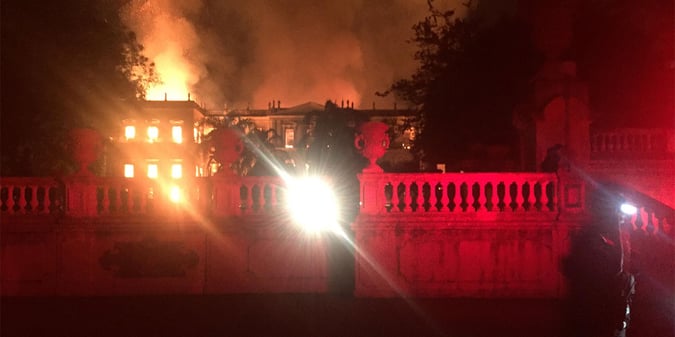
On September 2, 2018 the Museu Nacional (Brazil’s National Museum) experienced a terrible fire that led to an estimated loss of more than 20 million specimens and artifacts – approximately 90% of its collection.
As the oldest scientific institution of Brazil, the museum was best known for its anthropological and natural history collections which included its prized invertebrate collection, recordings of extinct indigenous languages, and Luiza - a 12,000-year-old skull and one of the oldest human-remains fossils found in the Americas. The museum’s collection in these areas is so vast that it’s considered one of the largest natural history and anthropology museums in the Americas. At the time this post was written, the immediate cause of the fire was still under investigation. However, everyone has acknowledged the true underlying cause of the fire was institutional decay due to a lack of consistent and appropriate-level funding.
A History of Decay
Among the many reports that have emerged over the last few days, it was noted that the museum didn’t have a sprinkler system. In addition, more than a decade ago inspectors raised a warning about the museum’s electrical wiring. Over the last couple of decades there has been a history of numerous funding complaints and even a crowdfunding effort to deal with termites that had closed nearly a third of the exhibition rooms. The museum had an operating budget averaging out to less than $.01 per artifact—and even with that, the funds were not reliably disbursed due to the government’s own budgetary inadequacies. It’s reported that government officials ignored pleas from the museum staff while at the same time refusing substantial offers of monetary assistance from institutions such as The World Bank—though it should be noted these offers were not without strings.
A Bad Budget Can Be Damning
Alexander Kellner, recently made Director of the Museu Nacional, used the museum’s 200th anniversary in June to raise the alarm once again, and request adequate funds to update the museum’s decaying infrastructure—specifically the sprinkler system. As some reports have confirmed, it appears that a sprinkler system was finally added to the budget, a budget that wouldn’t be adopted until October. When museums lack the proper operating budget to maintain minimum safety measures, it’s only a matter of time before a catastrophic event will occur.
Who is Responsible?
While there is certainly plenty of blame to go around we must recognize that inadequate funding for museums and their subsequent decay are deeply systemic issues for museums everywhere—even in countries viewed to have more successful economies and with world-class collections. This is an issue that must be tackled and addressed at every level, from museum staff and government officials, to national and international organizations whose mission it is to protect against devastating cultural heritage loss. In this situation, some have contended that the United Nations Educational, Scientific and Cultural Organization (UNESCO) should be taking a leadership role in fighting system-wide institutional decay.
“I hope we learn from this. Other public buildings are in the same situation.”
-Cristiana Serejo, Museu Nacional deputy director
Indeed, Serejo is correct. We all must pay attention to this visceral warning and act. Below are a few lessons learned from this event to which every museum should pay attention.
8 Lessons to Learn
- The storage and display of vast amounts of historical artifacts should NOT be undertaken in centuries old buildings. They require preservation-standard storage and well-maintained facilities.
- Don't put off facility maintenance! The museum can’t survive (let alone thrive) with delays in funding or cuts to the budget.
- Insure the building and collections to the greatest extent possible.
- The preservation and display of art, history, culture, and scientific research must be a higher priority for every city, state, and nation's government. A museum’s assets are an invaluable inheritance that belongs to everyone and they need to be treated as such.
- Museums and cultural heritage organizations everywhere need to equip themselves with better tools and strategies for self-advocacy, specifically funding advocacy.
- Digitization must be employed as a method to safeguard complete information loss. Ensure there are proper digital preservation standards in place so that digital data isn’t stored at the same physical location as the artifacts.
- “Museums are forever” is a fallacy and it’s a concept that must be challenged and changed within the minds of museum staff, the public, researchers, cultural organizations, and governments.
- The institutional decay within museums paired with the increasing likelihood of natural disasters (due to climate change) will only increase the likelihood of similar, disastrous events.
Salvaging from the Wreckage
Though nothing can ever replace the millions of artifacts, history, and research lost in the September 2 fire, some are hoping to collect the fragments of what remains. Students from the Federal University of the State of Rio de Janeiro have launched an image collecting initiative to build an archive of images taken at the Museu Nacional. The student group requests images of the museum and its objects be sent to the following e-mail addresses: thg.museo@gmail.com, lusantosmuseo@gmail.com, and isabeladfrreitas@gmail.com. Already, thousands of images have been uploaded.


